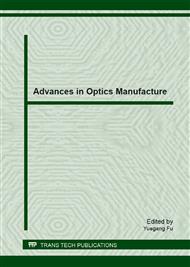p.111
p.115
p.124
p.131
p.137
p.142
p.147
p.152
p.158
Small Pitch Tool for Removing Middle Spatial Frequency Errors
Abstract:
More and more optical elements are needed in modern industry, which is reflected by both the bigger amount of requirement, and more complicated designed surface such as asphere and even free form surface. As a result, optical polishing using small tools on CNC machines is applied widely in the whole world, which has a lot of advantages such as fast speed, high accuracy, high flexibility and so on. But the small tool polishing can also cause in some problems. For example, the middle spatial frequency errors (MSFE) may be increased during the polishing. The reasons may consist of the following aspects: 1) the positional error of the workpiece; 2) the mistake of error data input; 3) the unexpected stop of the polishing process; 4) the stabilization of the slurry density during the process; 5) the temperature change of the contact area between the tool and the workpiece and so on. As is known, pitch is usually used in traditional optical manufacture, and it can reduce the middle and high spatial frequency errors in a large extent because of the different removal rate between the high points and low points on the optical surface. Therefore, the application of the combination of pitch and small tool is described in this paper in order to solve the MSFE problem, and we have got good polishing results of reducing the error from 2.155nm to 0.267nm by using the new pitch tool on the CNC machine after two runs.
Info:
Periodical:
Pages:
137-141
Citation:
Online since:
May 2013
Authors:
Keywords:
Price:
Сopyright:
© 2013 Trans Tech Publications Ltd. All Rights Reserved
Share:
Citation:


